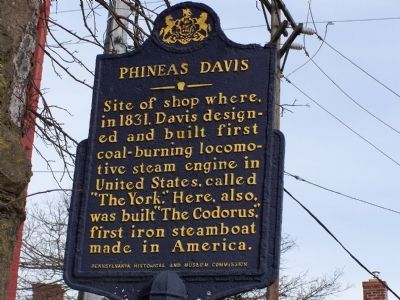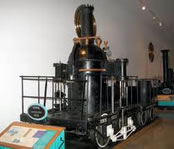This Week in History
June 21-27, 2015
Special from the Committee of Correspondence[1]
B&O Railroad Awards Prize for Coal-Fired Engine
(June 27, 1831)
By Pam Lowry
 Beverly Pfingsten, Jan.5, 2008, courtesy of HMdb.org
Marker at site of Phineas Davis's shop. Click on image to visit page. |
June 27, 1831—The new Baltimore & Ohio Railroad announced today that Mr. Phineas Davis of York, Pennsylvania is the winner of their national competition to design the first American coal-fired steam engine. Mr. Davis’s engine, which he has named “The York,” excelled three others in the trials held in Maryland today. The engine weighs less than three and a half tons, and is capable of pulling a fifteen-ton load at more than fifteen miles an hour. Mr. Davis received a prize of $4,000, beating out the “James” from New York, the “Costell” of Philadelphia, and the “Johnson” of Baltimore.
Although the B&O Railroad originally operated with horse-drawn trains, it soon moved to steam locomotion, which would be necessary for the long rail journey to the projected terminus at the Ohio River. In 1829, Mr. Peter Cooper of New York designed the “Tom Thumb,” a wood-burning steam engine which ran at speeds up to eighteen miles an hour.
The “Tom Thumb,” however, was an experimental model and was not practical for regular service. Two other methods of locomotion were tested, but with little success. One was a car carrying a horse which walked upon a treadmill geared to the wheels. The other was a car with a sail like a ship, named the “Aeolus.” The Russian ambassador to the United States had such a thrilling ride on the “Aeolus” that he sent a model of it to the Czar, thus encouraging renewed interest in the building of a St. Petersburg-Moscow railway.
 richardkruse.com
York locomotive. Click on image to visit page. |
The directors of the B&O finally decided that using coal as fuel was superior to wood-fired boilers. They therefore announced their national design competition in January of this year. The chief technical problem involved in the design was that a locomotive large and powerful enough to be practical might not also be able to negotiate the railroad’s sharpest curves. “The York,” however, not only sped around the sharpest turns at fifteen miles per hour, but on the straightaway it achieved the unheard-of speed of thirty miles per hour. A survey done by the railroad shows that locomotives such as “The York” can be operated for about $16.00 a day, whereas the same amount of work done by horsepower would cost about $33.00.
Mr. Davis’s achievement is all the more remarkable because he was orphaned in his ’teens and had to set out looking for work. His search took him on foot from his birthplace in New Hampshire to York, Pennsylvania where a kindly clockmaker taught him his trade. When he heard of the national contest, Mr. Davis built and tested his engine, then dismantled it into pieces and trundled it by oxcart down the turnpike to Baltimore. An announcement is expected shortly that the talented Mr. Davis will soon be hired as chief mechanical engineer of the Baltimore & Ohio Railroad.
Footnote
[1] The Committees of Correspondence, best known from Benjamin Franklin’s work, were the American colonies’ means for maintaining communication lines in the years before the Revolutionary War. In 1764, Boston formed the earliest Committee of Correspondence to encourage opposition to Britain’s stiffening of customs enforcement and prohibition of American paper money. The following year, New York formed a similar committee to keep the other colonies notified of its actions in resisting the Stamp Act. In 1773, the Virginia House of Burgesses proposed that each colonial legislature appoint a committee for intercolonial correspondence. The exchanges that followed built solidarity during the turbulent times and helped bring about the formation of the First Continental Congress in 1774. The Committees continued to function in the following years as a US Intelligence Service.
